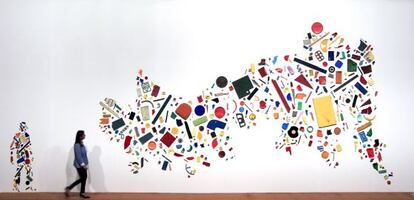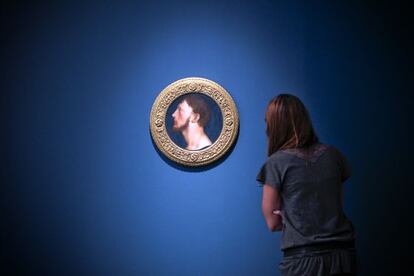The artistic fruits of isolation
A new Madrid exhibition sets out to trace the idiosyncratic path taken by British creators The focus stretches from the Tudor period to the Thatcher years

This fall's ambitious exhibition on British art at Madrid's Juan March Foundation also displays some very English passions, such as making lists, accumulating knick-knacks, and providing lessons in history. Like one of those manuals published by Oxford University to help the uninitiated get started on a variety of fields of human knowledge (from Edwardian fiction to Christian thought or Italian food), the exhibition Treasure Island. British art from Holbein to Hockney, whose title finds inspiration in the work of Robert Louis Stevenson, takes us on an apparently light-hearted journey across five centuries of painting and sculpture. It is art created between the late 16th century and the Thatcher era, a result of what in foreign policy terms came to be known as "splendid isolation."
The goal of Manuel Fontán, the foundation's exhibition director, and Richard Humphreys, curator of the show, is to bring British art closer to Spanish audiences, who are familiar with art from other parts of the world - Italy, France and the Netherlands - but hardly conversant with the social satire of James Gillray, the horse paintings of George Stubbs or the vorticist sculptures of Henri Gaudier-Brzeska.
A walk through the Juan March exhibition rooms shows that for once, the place does not look like the sophisticated apartment of an unmarried gallery owner from the 1970s, and instead has morphed into the cluttered attic of an English family home (there are 180 pieces on display). Closer inspection also shows that of the 80 individuals and institutions that loaned work for the exhibition, only a handful are Spanish, underscoring that centuries of rivalry between the empires and various other whims of fate kept Spanish monarchs and collectors mostly uninterested in British art.

Most of the work comes from museums and private collections in the United States, Portugal, Switzerland, Germany and of course, Britain. The show as a whole includes essential works, little-known pieces and agreeable surprises, testimony to the difficult gathering process that came before it.
"There were names that simply could not be absent," explains Fontán about the two years that elapsed between the time that the idea was floated and its completion.
The artist, author and manifesto writer Wyndham Lewis is a key figure in one of the seven areas into which the show is divided. But his vorticist cry is confronted with the elegant pictorial disdain of the Bloomsbury crowd and the viperish look of social commentator Lytton Strachey.
Memories of the post-impressionist exhibition of 1912 are the starting point for 20th-century art, from the wartime work of Meredith Frampton to the hypnotic sculptures of Henry Moore. There are the usual suspects - Lucian Freud, Francis Bacon and David Hockney - and references to British hegemony in the nascent mass culture: the final part of the show includes unavoidable icons like Peter Blake's cover for The Beatles' Sgt. Pepper album, and Richard Hamilton's famous series on Mick Jagger in handcuffs.
Lewis' vorticist cry is confronted with the pictorial disdain of the Bloomsbury set
The chronological order is only broken at the beginning, when visitors are taken through the Anglican reform to the Pre-Raphaelites and their academic obsessions, stopping at English Baroque art and the great landscapes of Turner and Constable. A sculpture by the Renaissance artist Torrigiano (1472-1528), who was famous for breaking Michelangelo's nose before ending up at the English court, looks out at a 1945 piece by land artist Richard Long, located behind a window, in the garden.
Nor is the sculptor from Florence the only foreigner considered British by this show. Hans Holbein the Younger and Van Dyck are there, as is Marcus Gheeraerts, a Flemish portraitist who was a favorite of the Tudors. The curator, Humphreys, goes even further by considering the fortification of Pomeiooc, in the Americas of 1585, one of the key settings for the development of British art - just one on a list of places that includes Eton, Roger Fry's Omega Workshops and Bacon's studio.
After viewing the show, one is tempted to wonder what it is that defines British art, and whether it would not be better to let ourselves get carried away by that famous if ill-meaning statement by Jean-Luc Godard ("we could talk about post-WWII English cinema if such a thing existed").
Tu suscripción se está usando en otro dispositivo
¿Quieres añadir otro usuario a tu suscripción?
Si continúas leyendo en este dispositivo, no se podrá leer en el otro.
FlechaTu suscripción se está usando en otro dispositivo y solo puedes acceder a EL PAÍS desde un dispositivo a la vez.
Si quieres compartir tu cuenta, cambia tu suscripción a la modalidad Premium, así podrás añadir otro usuario. Cada uno accederá con su propia cuenta de email, lo que os permitirá personalizar vuestra experiencia en EL PAÍS.
¿Tienes una suscripción de empresa? Accede aquí para contratar más cuentas.
En el caso de no saber quién está usando tu cuenta, te recomendamos cambiar tu contraseña aquí.
Si decides continuar compartiendo tu cuenta, este mensaje se mostrará en tu dispositivo y en el de la otra persona que está usando tu cuenta de forma indefinida, afectando a tu experiencia de lectura. Puedes consultar aquí los términos y condiciones de la suscripción digital.
Últimas noticias
NASA discovers Titan doesn’t have an ocean, but a ‘slushy ice layer’ that increases possibility of life
Innocence lost in the forest of the child soldiers: ‘Each leader of the armed group had his girls’
‘Fallout’ or how the world’s largest company turned an anti-capitalist apocalyptic Western into a phenomenon
From inflation to defending migrants: Eileen Higgins and Zohran Mamdani inaugurate the new Democratic resistance against Trump
Most viewed
- ‘El Limones’ and the growing union disguise of Mexican organized crime
- Christian Louboutin: ‘Young people don’t want to be like their parents. And if their parents wear sneakers, they’re going to look for something else’
- The low-cost creative revolution: How technology is making art accessible to everyone
- ‘We are dying’: Cuba sinks into a health crisis amid medicine shortages and misdiagnosis
- Liset Menéndez de la Prida, neuroscientist: ‘It’s not normal to constantly seek pleasure; it’s important to be bored, to be calm’









































